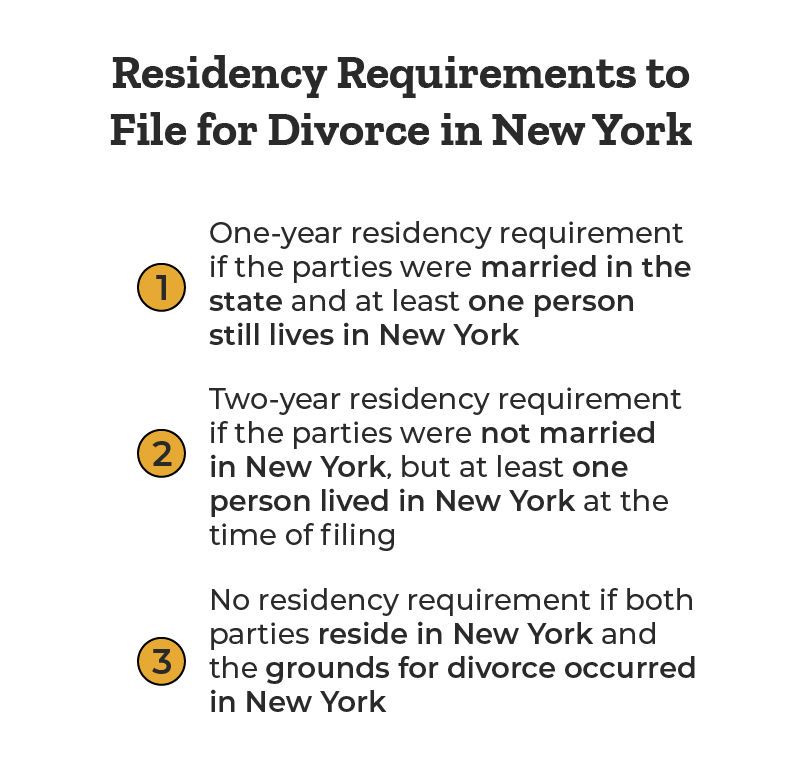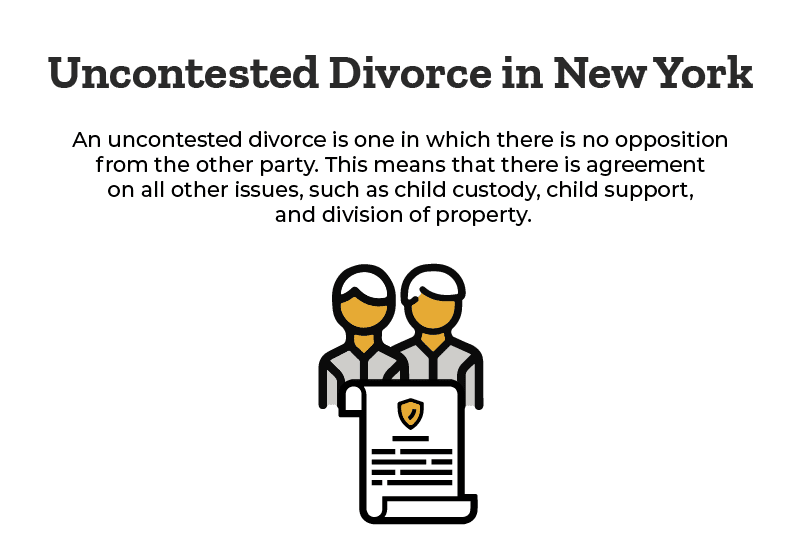Each state has the power to make family laws and govern residents’ divorce cases. Regarding New York, family laws are codified in the New York Domestic Relations Law. In particular, the laws regarding divorce are covered pursuant to DRL Section §170: Action for Divorce. The New York law provides seven divorce grounds or ways in which a divorce action may be requested and brought before family judges in the New York Supreme Court. People may choose to either file a no-fault or fault-based divorce ground.
Every state has its own rules, and every couple has a unique divorce situation. That is why it is always best to consult a New York divorce attorney or an experienced family law firm to determine how the circumstances of your divorce case may pertain to state-specific domestic relations law.
Residency Requirement

There is a residency requirement to live in New York if a party wishes to file for divorce in New York. There is a one-year residency requirement if the parties were married in the state, and at least one person still lives in New York. If the parties were not married in New York but at least one person lived in New York at the time of filing, then there is a two-year residency requirement for that party. In cases where at the time of filing, both parties resided in New York, and the grounds for divorce occurred in New York, there is no residency requirement.
No-Fault Divorce
New York in the last 10 years has introduced “no fault” as an option to end a marriage. In a no-fault divorce, one declares an unrecoverable breakdown of the marriage and does not assign blame for the breakup. One party can unilaterally declare that the marriage is over, and there is no way for the other spouse to veto the termination. As one party can decide to end the marriage, it is certainly possible that the other spouse may oppose ending the marriage. However, under the no-fault grounds, only one party needs to petition, and the other party does not have any legal rights to object to the divorce.
The requirement for a no-fault divorce in New York is that one spouse proclaims under oath that the relationship has broken down irretrievably for six months.
Interestingly, New York was one of the final states in the union to add a no-fault divorce option. Traditionally, one could only end a marriage if they had an egregious claim against their spouse. As the New York State Legislature valued the sacredness of marriage and potential for reconciliation, the state was hesitant to add a no-fault ground based on their belief that it would make it easier for people to divorce. Nonetheless, the state eventually added the “irretrievable breakdown” option.
Other Divorce Options

A divorce with no-fault grounds is also commonly referred to as an “uncontested divorce”; however, that may or may not be the case. An uncontested divorce is defined as one that has no opposition from the other party. This means there is agreement on all other issues, such as child custody, child support, and division of property. Often, parties do not even need a divorce attorney, as they can pay the filing fee and fill out the divorce forms themselves. As contested divorces have an agreement and no further legal objections, they are usually finalized quickly and with substantially less legal fees than a contested divorce proceeding.
Filing for a Divorce Based on “Fault” in New York

A divorce action in New York that is based on fault can be filed for any one of the following grounds: cruel and inhumane treatment, abandonment, imprisonment, adultery, or living separate and apart pursuant to an agreement.
Cruel and Inhuman Treatment
The divorce ground of cruel and inhumane treatment is defined in New York Domestic Relations Law §170 as “conduct of the defendant so endangers the physical or mental well-being of the plaintiff as renders it unsafe or improper for the plaintiff to cohabit with the defendant.”
Generally, documented domestic violence provides evidence of cruel and inhumane treatment, but victims of mental abuse are also included in this category. Mental and emotional abuse that has affected a spouse’s well-being has been shown to qualify under this statute, especially in cases where there have been consistent patterns by a spouse to degrade their partner’s emotional health intentionally. New York courts have also included situations in which one spouse deliberately withholds sex from the other spouse. Family law judges have found maliciously withholding marital relations as an act of inhumane treatment to award a divorce based on fault.
Abandonment
For a judgment of divorce based on abandonment, the petitioner must prove that his or her spouse left the marriage for at least one year before filing. Abandonment can be interpreted as either actual or constructive. In an actual abandonment, one spouse completely leaves the marriage and moves away from the marital home, sometimes without any notice. In a constructive abandonment, the deserting spouse may have been compelled or encouraged to leave by the other spouse; however, the lack of performing marital duties and staying together can be legally construed as abandonment.
Imprisonment
To obtain a New York divorce based on imprisonment, the petitioner must show that his or her spouse was confined in prison for a minimum of three consecutive years before the filing of the divorce papers.
Adultery
A New York divorce can also be filed based on the fault divorce ground of adultery. Adultery in New York Domestic Relations Law §170 (4) is defined as “the commission of an act of sexual or deviate sexual intercourse, voluntarily performed by the defendant, with a person other than the plaintiff after the marriage of plaintiff and defendant.” Thus, one must be able to prove that their spouse willingly had sexual relations with another person during their marriage.
Often, a person must show evidence of catching his or her spouse “in the act,” as it is not enough proof to show evidence such as text messages or phone calls. Additionally, even with compelling proof, there are many legal defenses for adultery. These defenses include connivance, condonation, and recrimination. Connivance is a defense when the spouse either consented to or encouraged the cheating. Condonation is a defense to adultery when the spouse had previously forgiven the other spouse for the discretion. Recrimination is a common defense to adultery when it can be proven that both spouses are guilty of adultery. Furthermore, a claim of adultery has a statute of limitations, meaning a person cannot use adultery as grounds if the allegation of adultery occurred more than five years before filing the divorce action.
Proving adultery in a New York divorce case requires convincing evidence and can be contentiously fought with defenses. For these reasons, although adultery is commonly brought before the family courts, it is not always successfully established.
Living Separate and Apart Pursuant to an Agreement
The last option under New York fault-based divorce grounds is a divorce following a period of living separate and apart. Family law instructs that one must have lived separate and apart pursuant to a separation agreement for a period of at least one year before filing divorce forms. The separation agreement must be in writing and can be obtained two ways: a court order or decree of judgment of separation or by a written separation agreement mutually agreed on, with the separation agreement filed by the clerk’s office in the county where either party resides.
For a judgment of divorce based after a period of legal separation, parties must prove mutual consent for living apart and in real life live apart, including ceasing all martial duties, such as sexual relations between each other. A divorce judgment can be denied in cases where parties briefly reconciled during the one-year separation requirement. Additionally, all terms of the original separation agreement or court order must have been followed, including any temporary alimony, child support, or property division.
Before the inclusion of a no-fault divorce option in New York, many parties that did not have “fault” were forced to obtain a divorce judgment under this provision. Nowadays, the separate and apart divorce ground is not frequently used. However, this is an option for many couples considering divorce but who are still debating reconciliation.
Reasons for Choosing a Fault-Based Divorce Ground
Choosing to file a divorce based on spousal fault could add drama to your divorce process. For one, parties will have to go before a family court offering proof and testimony to the allegations. Witnesses may also need to be subpoenaed to testify. Many petitioners want a sense of justice, and sometimes, proving fault can benefit your case. If you have questions regarding extreme fault on behalf of your spouse during your marriage, it is best to consult with a qualified divorce lawyer to discuss your options.
Judgment of Divorce Will Not Be Granted Until All Issues Are Settled
Before granting a judgment of divorce, all other extraneous issues must be settled. This means that financial issues, including spousal support and equitable division of property, need to be finalized. Additionally, any issues involving minor children must be dealt with, including legal custody, physical custody, and child support issues.

Can a Fault-Based Divorce Claim Help My Child Custody or Child Support Case?
In New York, the stand for determining child custody is the “best interest of the child.” The child support standards look at the incomes of the parents. Filing a fault-based claim most likely will not influence the court-ordered child support or custody arrangements.
Many times, if one has additional issues of child custody and spousal support as a part of their divorce case, they may think filing a fault-based claim will help them in other areas. For example, if one files for divorce based on cruel and inhumane treatment, then they might also argue that the violent history of their spouse proves that they should be the one awarded as the custodial parent and/or strip the other parent of legal custody. It is best to remember that while fault in a marriage may be looked at in the respect that it concerns a child’s safety, the legal standard considers custody based on many factors. Additionally, a parent’s conduct will not be considered in a child support award. Child support standards are determined only by economic factors of the paying parent and the custodial parent.
Can a Fault-Based Divorce Help Me Receive More Alimony?
Spousal support, or alimony, in New York is also determined by many factors, including the duration of the marriage, the age and health of the parties, and the earning capacity of the lower-income spouse. Permanent alimony is rare except in cases of a long-term marriage (20+ years) and where the lower-income spouse is either elderly or unlikely to find work to support themselves. Many times, the court may award “maintenance,” or temporary support, to help the lower-income spouse get back on his or her feet or to finish school to build his or her earning capacity.
Many people file a fault-based divorce to villainize their spouse before the family court to help them receive a greater alimony award. However, an adultery or abuse claim will not be considered in determining a court order for spousal support or property division. The court may consider situations in which there was extreme and egregious economic fault on behalf of one spouse (e.g., someone gambles money away, or spends it on drugs).
Separation of Property in New York Divorce – Equitable Distribution
For the equitable division of property, New York courts look to see which assets were accumulated during the marriage versus premarital property, which will remain separate. Assets acquired during the marriage can include stock gains, 401(k) plans, and pension accounts. Just because a marital asset is titled in one spouse’s name does not necessarily make it separate property. The court has the authority to divide all marital property according to “equitable distribution.” This means it will be divided by how the court sees fair and reasonable, given the couple’s duration of marriage and circumstances. It is important to remember that equitable division does not necessarily mean 50/50, although in some divorce cases, that may be the outcome.
